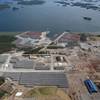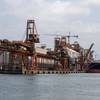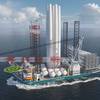French shipping giant CMA CGM plans to use Kingston Container Terminal, Jamaica as a strategic Caribbean transshipment hub for an enlarged Panama Canal. The Port connects to US East Coast, the Gulf of Mexico, the Caribbean and northern Brazil.
Kingston hub is centrally located in the Caribbean Sea, opposite the Panama Canal just one day’s sailing away, CMA CGM decided long ago to make this a strategic location.
“Establishing a hub in Panama would have lengthened the route for certain lines plying the region, while Kingston has all the advantages, both for the very big ships and all the others,” explains Olivier Tretout, CEO of the Kingston Terminal.
While around 10% of goods unloaded at Kingston are for the local market, 90% of volumes transhipped onto other vessels are heading off in all directions, East Coast and Gulf of Mexico.
A 30-year concession was signed between the Jamaican authorities and the CMA CGM Group (and its subsidiary Kingston Freeport Terminal Limited) to develop the container terminal’s staffing and technical capabilities: more than 900 employees, 2,400m of dock, 14 then 18 gantry cranes and a deeper channel, will all help to meet the new challenges.
“It’s a whole new network for everyone, that’s the issue,” says Olivier Tretout.
For CMA CGM, everything is now in place and it’s just a question of waiting until June 26th 2016 , the date set for the official opening of the “new look” canal.
Luc Portier, CMA CGM Director of Studies, Projects and Development, said: “Impressive works were conducted by the Panama Canal Authorities. A widened canal will bring new opportunities for world trade.
“CMA CGM has foreseen these changes and made Kingston a strategic base: modernisation works will allow the group to operate all larger vessels sailing in the area, and make Jamaica a transhipment hub for the whole sub region”.
As well as the widening and deepening of existing navigational channels, the makeover sees new lock systems that will be nothing like the old ones. Two sets have been built, one Pacific-side and the other on the Atlantic side, each comprising several water retention basins.
On the administration side, the old lock gates, “curved centenarians”, have been replaced by new rectilinear gates that slide into the walls once open, thus increasing the usable width. Another notable change: while the old locks took eight minutes to fill, the new ones, although much larger, will fill in just 10 minutes.
There are many anecdotes related to this massive project, including the meticulous operation to clear 400 hectares rigged with explosives in a former US Army shooting range along six kilometres of the channel leading to the Pacific coast.
In a few months, all these technical details will be forgotten and priority given to the new opportunities it provides for global trade. It’s important to remember that 90% of goods on international markets are carried on the world’s shipping routes: it is the safest and most economical mode of transport, facts that made it imperative to modernize the Panama Canal.
But to properly assess the consequences will take around three to five years, the time it takes for a gradual evolution to occur. The era of the Neo-Panamax is only just beginning…










